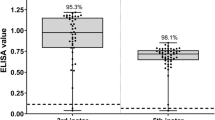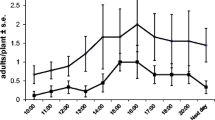Summary
Individual nymphs of the predaceous pentatomid Podisus maculiventris Say were each fed a single first instar Douglas Fir tussock moth larva, Orgyia pseudotsugata McDunnough, and held without further feeding at constant temperature for a known number of days before being frozen. Enzyme-linked immunosorbent assay, ELISA, was used to examine these predators for the presence of prey antigens. The concentration of prey antigens in these predators declined at a linear rate over the 7 days they were held post-feeding. Detectable antigens remained in 50% of the predators after three days at 24°C. On the day in which the prey was consumed (day 0) only 80% of the unstarved predators had detectable prey antigens which suggests the possibility of instinctive killing of prey with little or no subsequent ingestion. The amount of prey antigen in molted and unmolted predators was not statistically distinguishable; although molting interrupts feeding, digestion of the antigen(s) employed in this study seems to be continuous.
Similar content being viewed by others
References
Boreham PFL, Ohiagu CE (1978) The use of serology in evaluating invertebrate prey-predator relationships: a review. Bull Entomol Res 86:171–194
Fichter BL, Stephen WP (1978) Selection and use of host-specific antigens. Misc Publ Entomol Soc Amer 11:25–33
Greenstone MH (1977) A passive haemagglutination inhibition assay for the identification of stomach contents of invertebrate predators. J Appl Ecol 14:457–464
Miller MC (ed) (1979) Serology in insect predator-prey studies. Misc Publ Entomol Soc Amer 11:1–84
Murray RA, Solomon MG (1978) A rapid technique for analyzing diets of invertebrate predators by electrophoresis. Ann Appl Biol 90:7–10
Ohiagu CE, Boreham PFL (1978) A simple field test for evaluating prey-predator relationships. Entomol Exp Appl 23:40–47
Pickavance JR (1970) A new approach to the immunological analysis of invertebrate diets. J Anim Ecol 39:715–724
Richman DB, Whitcomb WH (1978) Comparative life cycles of four species of predatory stink bugs. Florida Entomol 61:113–119
Whalon ME, Parker BL (1978) Immunological identification of tarnished plant bug predators. Ann Entomol Soc Amer 69:948–958
Author information
Authors and Affiliations
Additional information
This research was supported in part by USDA/Forest Service Cooperative Agreement No. 226 and is Technical Paper No. 5849 of the Oregon Agricultural Experiment Station
Rights and permissions
About this article
Cite this article
Fichter, B.L., Stephen, W.P. Time related decay in prey antigens ingested by the predator Podisus maculiventris (Hemiptera, Pentatomidae) as detected by ELISA. Oecologia 51, 404–407 (1981). https://doi.org/10.1007/BF00540913
Received:
Issue Date:
DOI: https://doi.org/10.1007/BF00540913




